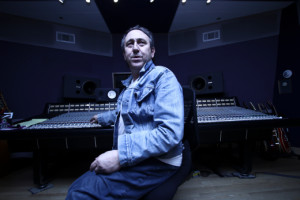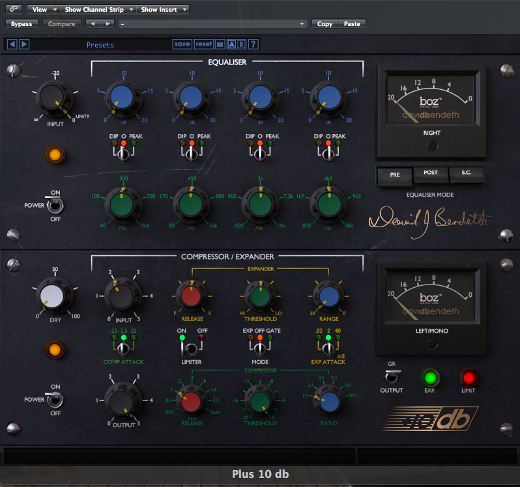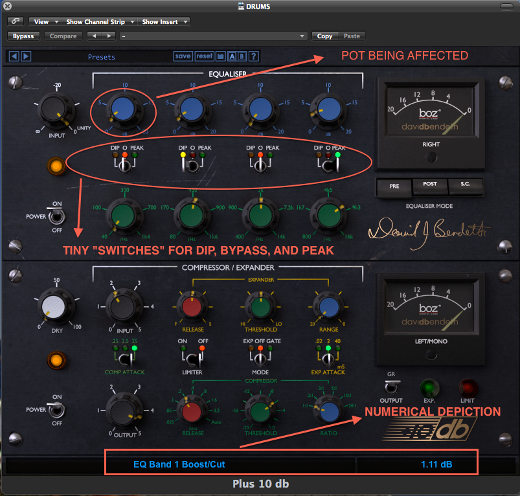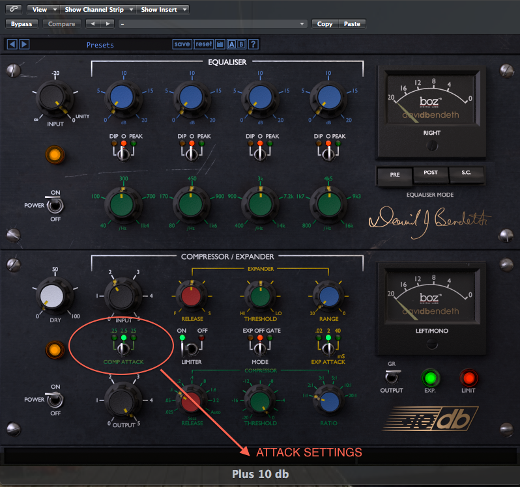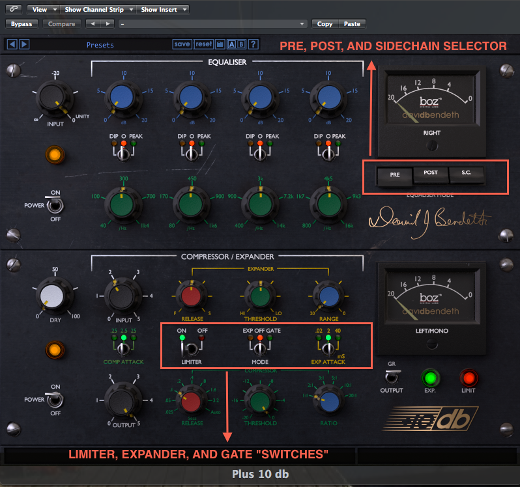Boz Digital Lab’s +10db – A Big Review of a Mixing Plugin
A friend of mine in the mixing/producing game refuses to use anything but the Waves CLA 76 on his vocal chain. Even though he believes other emulations of the famed hardware piece trounce the CLA—the UAD versions, the Softube mod found within Guitar Rig 5’s suite, the emulation issued with Slate Digital’s VMR—when mixing vocals, he still reaches for the Waves CLA 76 each and every time.
Why? Because in his estimation, that’s the sound hears on mainstream radio, regardless of what the top industry dogs may or may not actually use. He simply doesn’t want to veer away from what he perceives to be a time-tested formula in order in achieving his ultimate agenda—a radio hit.
This, I feel, is his loss. The last couple of years have brought forth many exciting detours from the well-traveled roads of Waves and UAD. There are now quite a few valid paths up the emulative mountain. Many of them sound great, are very powerful, and some of them are damned cheap to boot.
One such piece of software is Boz Digital Labs’ +10db. Named for David Bendeth (see his SonicScoop “Mix Analysis” and “My Go To Saturation” interviews), whose expertise was sought in modeling this plugin, the +10db is a recreation of two famed ADR units, one of which (the Compex) is often thought to be a key ingredient of the famed Led Zeppelin drum sound).
Recently, I got the chance to test this plugin, and I must say, I’m impressed with the results. I used the full channel strip version. The EQ and dynamics modules are also available separately at a lower price point.
A look at the GUI
Designed with the analog in mind, some aspects of this GUI are quite straightforward, while others need more explaining:
The EQ hovers at the top and the compressor occupies the bottom. The meters sit clearly on the right and the “power switches” (which effectively act as bypass buttons) sit on the left.
Less clear is how the EQ operates. Unlike your typical SSL or Neve mods, the default position for the decibel pot isn’t up the middle, with a twist to the left giving you attenuations and a turn to the right giving you boosts. Instead, you’re cranking from +/-0dB to +/-20 dBs. A switch located between the decibel and frequency knobs can be set to either “boost” (which ups the selected frequency), “dip” (which cuts the selected frequency), or “0” (which bypasses this gain stage entirely).
Also, it might take a minute to figure out that the numerical values of your changes are displayed across the bottom in a small blue font, as shown here:
The EQ’s operation may be counterintuitive at first to some users, but if you’ve ever messed about with the hardware unit this software approximates (or something similar) you’ll get the hang of it rather quickly. Even if you haven’t, you’ll probably figure it out in no short order, though switching between this EQ and another plugin might result in momentarily forgetting this aspect of the +10db’s functionality. (I tend to have such lapses in memory, at any rate).
Also counterintuitive is the placement of the compressor’s the attack settings.
In addition to the individual pots you see delineating “Release” “Threshold” and “Ratio”, the +10db provides you with another miniscule switch between the input and output knobs which affords you three separate attack times.
As you can glean by the limited attack times available, this compressor is not meant for “exact science” situations. You’re not getting a scalpel for surgical enterprises here. Instead, you’re getting a machete for clearing a bold path through the digital wilderness.
But this is not a bad thing. When you come to understand how this plugin works, you’ll achieve lively results, quite different from other emulations, as no one has else has modeled these particular hardware pieces yet. (And for the life of me, I can’t figure out why.)
Before we get to the audio comparisons, I’d like to point out a few particularities endemic to this channel strip. I think these points will prove useful in working with the plug:
1) Upon instantiating of the module, there is a noticeable jump in level. (Perhaps this is where the “+10” in “+10db” comes from). Keep this in mind as you do A/B tests between source sounds and affected material; you will need to iron out levels in order to mitigate that fleeting “louder sounds better” phenomenon.
2) Sometimes the smoothest compression (especially on drums) can be achieved at a ratio of 1:1. When kept at this minimal ratio, driving the input pot will accomplish more fluid feats of gain reduction, while attaining a nice crunch overall. (Again, quite useful on drums). Despite the counterintuitive 1:1 ratio setting, you’ll see the gain reduction needle ticking in the meter to the right of the compressor unit—if you aren’t hearing it already.
3) The limiter (which you can activate with yet another tiny switch between release pots) sounds truly epic when driving drums. Definitely play with the approach of juicing the input into this limiter, as it provides much in the way of character.
Additional Features
In my experience, if you’re going to use the EQ as a sidechain for the compressor—in de-essing a vocal, for instance—the result will be fairly broad in scope, unlike a more precise module like Fabfilter’s Pro-DS. The sidechaining apparatus won’t function surgically, in other words. Given the proper circumstance, this may be exactly what you’re looking for. Then again, it might not. The same general principle goes for the gate: this is a musical piece of software, rather than a clinical one.
While you can key in external sidechain inputs within Pro Tools (as you can with any software compressor) the plugin itself doesn’t have a sidechain input, so you can’t assign the compressor an external signal in Logic or other DAWs. I personally found this to be a drawback: I’d love to hear this particular compressor on a bass keyed to a kick drum.
Comparisons
A bit of a disclaimer is in order: One can’t conduct a true comparison between this plugin and other emulations of the Compex/Stressor, as no other approximations of such ADR equipment exist. Furthermore, I am not in possession of the original hardware, nor the reissues.
So I’m opting for two different types of comparisons here. The first is a simple before/after, in which we’ll see how this unit affects vocals, guitars, and the drum buss in the context of a specific mix.
The other approach will test a common method rather than a common emulation: As this plugin is a channel strip, I’ve decided to take a standard channel strip technique for drum buss processing (Graham Cochrane has a video explaining it in detail here) and apply the method to several different channel strip emulations: a bunch of SSL mods (because that’s what I’ve tended to use with this technique), and the +10db.
Essentially, this technique consists of high passing the kit at 20 hertz or so, dipping out a bit of 500, boosting a bit of 8K, and compressing the result by 3db (primarily heard on the snare), or thereabouts.
A couple of caveats:
On SSL mods, the gain reduction for this trick usually involves turning the threshold all the way down, coupled with utilizing a very low ratio setting—often as little as 1.4 to 1. These counterintuitive cranks seem particular to the SSL’s circuitry (and the modeling thereof). When it came to the +10db, I decided to achieve the same amount of compression by different means (a minimal ratio, an appropriate threshold, and futzing with the input/output as need be).
Another caveat: +10db doesn’t sport a moveable high pass filter, and its EQ only goes down to 40 Hz. Again, this renders an exact comparison between the two mods impossible, but still, I believe it’s worthwhile—We’re testing the overall flavor of the dish, not the brands of spices involved.
Acoustic drums
As I’m working on an EP for the Chicago based band Empire State Express, I used a few examples from those sessions for the acoustic comparisons. The following is a drum loop taken from their tune “Seismic.” This is an apt choice, I believe, because the drum part has the proper Bonham bombast:
AUDIO EXAMPLE 1 – SEISMIC DRUMS, NO BUSS PROCESSING:
As you can hear, this is a raucous, mid-tempo 4/4 drum beat. There was no processing in that example on the drum buss. So let’s hear what happens when I apply the aforementioned channel strip technique through a variety of emulations, culminating in the +10db.
AUDIO EXAMPLE 2 – SEISMIC DRUMS, WAVES SSL CHANNEL:
AUDIO EXAMPLE 3 – SEISMIC DRUMS, WAVES SSL G CHANNEL:
AUDIO EXAMPLE 4 – SEISMIC DRUMS, UAD SSL BLACK:
AUDIO EXAMPLE 5 – SEISMIC DRUMS, UAD SSL BROWN:
AUDIO EXAMPLE 6 – SEISMIC DRUMS, +10DB:
In each example, roughly the same settings were used to achieve the desirable amounts of EQ and compression (the 10db being the exception in certain parameters). Yet, as you can plainly tell, all of them sound quite different:
The Waves SSL channel strip provides a smooth high end, a rounder kick drum, and perhaps a narrower stereo focus on the kick and snare; the Waves SSL G Channel is perhaps more driving, more forward, and more console-like—though we may have lost some of the roundness on that kick drum; the UAD mods unquestionably have more “life” in them (at least to my ears) than their waves counterparts, with the black version providing a clear gloss on the cymbals as well as pleasing mid range emphasis, and the brown giving a more refined, subtle take on the technique.
Then, there’s the +10db, which has a character all its own: a crazy smack to the transients, a buoyancy between hits, an aggressive upper mid range (though not tinny), and a presence to the cymbals unique to the +10db.
In my opinion, no example is inherently better or worse than the other, but each is palpably different. Yes, the +10db stands out because it’s not an SSL emulation. But on the flipside, one could say this is a virtue: it stands out because this is an emulative horse of a different color—a module not previous offered within the constraints of the digital world.
That’s all well and good for acoustic drum buss processing, but how about a more electric offering? How do 808s and claps and reverse cymbals stand up to the channel strip comparison?
Electric Drums
Let’s take a gander. Here’s a quick electronic beat I drummed up for you guys.
AUDIO EXAMPLE 7 – ELECTRIC DRUMS, NO BUSS PROCESSING
And here’s a similar slate of comparisons:
AUDIO EXAMPLE 8 – ELECTRIC DRUMS, WAVES SSL CHANNEL:
AUDIO EXAMPLE 9 – ELECTRIC DRUMS, WAVES SSL G CHANNEL:
AUDIO EXAMPLE 10 – ELECTRIC DRUMS, UAD SSL BLACK:
AUDIO EXAMPLE 11 – ELECTRIC DRUMS, UAD SSL BROWN:
AUDIO EXAMPLE 12 – ELECTRIC DRUMS, +10DB WITH LIMITER:
AUDIO EXAMPLE 13 – ELECTRIC DRUMS, +10DB NO LIMITER:
Again, a different array of results, none inherently better, but all interesting. I’ll spare you the adjectival descriptions this time, except to say that the +10db gives you a hell of a lot of character: the reverbs stand out a bit more, the overall sound is chunkier and more dominating. All and all, the sonics are less clear than the SSL mods (at least, to my ears), but also more bombastic: there’s more rumble on the kicks, more presence to the high mids.
(Note that for this comparison, I opted to show you the difference between slapping a limiter on the +10db and taking it off; I didn’t include such a test for the acoustic drum buss set because in that instance, the drums never actually triggered the limiter.)
Now, onto the before and after comparisons.
Before and After Comparisons
For these tests, I opted to use another mix I’m working on for Empire State Express, this one called “Jackie Chan.” It’s a faster, more aggressive rock song with a distinctly garage feel to it.
Here’s an excerpt of the intro guitars, unaffected, panned left and right.
AUDIO EXAMPLE 14 – JACKIE CHAN GUITARS, NO PROCESSING:
Perhaps the most noticeable element of these guitars is a disconcerting rattling noise in the higher frequencies; it sounds quite like an old man wheezing. This problem is in the source file, and could be the result of a great many variables. Whatever the cause, the wheeze needs to be whittled down. I could use iZotope RX for the job, but for the sake of this review, I’d rather see what we can do with the +10db.
I’d also like to breathe more life into these axes—give them more body while retaining the edge. Let’s see if the +10db is up to the job.
AUDIO EXAMPLE 15 – JACKIE CHAN GUITARS, +10db:
The wheezing is not entirely gone, but we’ve certainly tamped it down; in the mix, it works. More importantly, with a couple of small boosts (one around 200hz, another at 3k), we’ve given the guitars more body without sacrificing much bite. The compression also glues the guitars together and lends an appropriate chunkiness to the overall sound.
Now, onto the vocal. Here’s what the vocal sounded like without processing:
AUDIO EXAMPLE 16 – JACKIE CHAN VOCAL, NO PROCESSING:
The vocal is a little thin to my ears, with a pinched nasal quality. Also, the sibilance is unbecoming. We simply must do something about it.
So let’s see what happens if we apply two instances of the +10db in tandem—the first functioning as a de-esser (with a hefty boost at 6k feeding the compressor’s sidechain), and the second operating as a channel strip.
AUDIO EXAMPLE 17 – JACKIE CHAN VOCAL, +10DB:
With a small boost at 180 cycles and a few dips at 81 hertz, 3k and 6.5k, the vocals have liftoff: more body, a nice “garage” bite, and an overall tightness lacking before. To be sure, the esses and other sibilances are still too harsh—and perhaps too affected—but as I said before, the +10db doesn’t provide a surgical approach in such matters. Also, we want this rock vocal to spit a little bit on phrases like “give the parasites their lunch.”
I deem this an overall improvement, and in the mix, I think these vocals sit pretty well. Keep in mind, the mix is still in its infancy, so perhaps we’ll end up applying a Fab Filter Pro-DS, or pulling the clip gain down on certain esses. Still, let’s here what we’ve got, all in all.
AUDIO EXAMPLE 18 – JACKIE CHAN ROUGH MIX, NO DRUM COMPRESSION:
This is a rough mix of the intro as it stands right now (I’m sure it will be refined as the mixing process moves on).
Some basic problems: the open hi hat is a bit woozy for me—there’s a frequency hitting me the wrong way—and the bass seems to mask some of the kick hits.
Let’s see what happens if we run the kick and snare through a parallel compression chain consisting of the +10DB.
AUDIO EXAMPLE 19 – JACKIE CHAN ROUGH MIX, ADD +10DB DRUM COMP:
We certainly hear that kick now—perhaps a little too much (and perhaps because I exaggerated the drum-comp buss to show off what the +10db adds).
So let’s refine it a bit more, and also, let’s deal with those annoying high hats. What’s more, let’s do it by limiting ourselves to only two options: balancing the drums, and applying an instance of the +10db across the entire drum buss (or both drum busses—I’m using two: one for the shells, and one for the cymbal pieces).
AUDIO EXAMPLE 20 – JACKIE CHAN ROUGH MIX, +10DB ACROSS DRUM BUSS:
Once again, the +10db adds a lot of color to the drums on this mix. It also helps brighten the high hats while mitigating some of those 4k and 11k trouble spots (though not entirely).
Conclusions
The 10db is a musical prickly pear. Obviously, it’s not for every situation, and it’s not suitable to everyone’s individual tastes. However, this plugin offers something heretofore unavailable in the digital world: a great sounding mod of two famed ADR units, often called “secret weapon[s] ” by industry insiders. Moreover, Boz Digital Labs is putting these emulations out for an unbelievably cheap cost: an introductory price of $99.00, and a regular price of $199 thereafter.
So it’s up to you: do you want to be like my friend, and stay with your same-old software choices simply because that’s what the pros claim to use, or would you like be in on the ground floor of a new digital experience without the hassle of spending over two hundred dollars for the privilege?
I know where I stand.
– As a composer of musicals, Nick Messitte has seen his work enjoy the stages of Edinburgh’s Fringe Festival and New York’s Musical Theater Festival to critical acclaim; as a guitarist, he’s played with internationally renowned musicians, including Sam Rivers, Hawksley Workman, Gary Thomas, Devin Grey and Daniel Levine. Nick is also a sound designer of theater and film (with credits such as the award winning I Hate Myself and Sumi) and a producer/engineer of records (credits include Bullet Proof Stocking’s critically acclaimed EP Down To The Top, which Nick mixed, mastered, and supplied with additional instrumentation). Lastly, he is a writer/cultural critic, whose musings can be seen regularly at Forbes.com.
Please note: When you buy products through links on this page, we may earn an affiliate commission.







